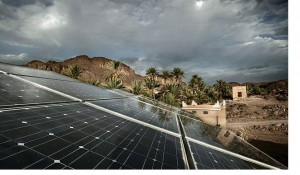SATURDAY, 21 MAY 2011
 Renewable sources can play an important role in tackling problems of energy security and global warming [1]. The two reliable methods that currently use sunlight involve panels of solar cells that directly create an electric current or an array of mirrors that concentrate the sun’s rays onto a body of water, which produces steam that is used to drive a generator.
Renewable sources can play an important role in tackling problems of energy security and global warming [1]. The two reliable methods that currently use sunlight involve panels of solar cells that directly create an electric current or an array of mirrors that concentrate the sun’s rays onto a body of water, which produces steam that is used to drive a generator.Scientists from the Massachusetts Institute of Technology have demonstrated how a third method, based on the thermoelectric effect, might be used instead and at a much lower cost [2]. Thermoelectric materials generate an electrical potential difference within themselves if one part is hotter than another. This can be used to drive a current through a circuit, but is only efficiently achieved if there is a considerable temperature difference within the system. By dividing the thermoelectric material, bismuth telluride, in their device into nanoscale pellets and then covering it in anti-reflective coatings of hafnium, molybdenum and titanium, the researchers maximized heat absorption and conducted it rapidly to and from the bismuth telluride.
Although the amount of electricity they generated from their prototype was poor compared to that achieved with silicon-based solar cells, the researchers believe their system has promising potential as a dual power-generating and water-heating device [3].
Written by Robert Jones
References:
- http://www.decc.gov.uk/en/content/cms/what_we_do/uk_supply/energy_mix/renewable/explained/introduction/introduction.aspx
- High-performance flat-panel solar thermoelectric generators with high thermal concentration. (2011) Kraemer,D., Poudel,B., Feng, H.-P., Caylor, J.C., Yu,B., Yan,X., Ma,Y., Wang,X., Wang,D., Muto,M., McEnaney,K., Chiesa,M., Ren, Z. & & G. Chen. Nature Materials DOI:10.1038/nmat3013
- http://www.economist.com/node/18678935?story_id=18678935&fsrc=rss
